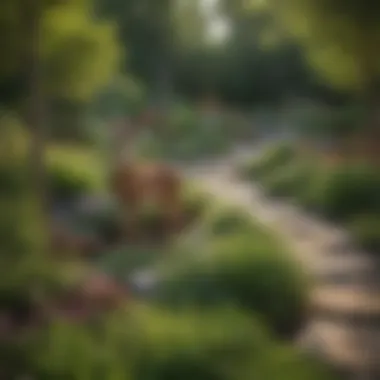Constructing a Deer Resistant Perennial Garden


Intro
Creating a garden that is both beautiful and resistant to the persistent grazing of deer is a challenge many homeowners face. As urban and suburban habitats encroach into deer territories, these animals are increasingly drawn to residential gardens. Understanding the reasons behind their attraction helps in developing strategies to mitigate the impact of deer on our plants.
A deer-resistant garden not only preserves the aesthetic appeal of your outdoor space but also promotes biodiversity by encouraging a variety of plants that thrive without deer interference. The following sections will provide insights into effective design inspirations, practical tips on maintenance and care, along with budgeting and planning strategies that ensure a sustainable approach.
By engaging with local wildlife and considering sustainable practices, gardeners can create a vibrant, eco-friendly environment.
Design Inspiration
Designing a deer-resistant garden involves creativity as much as strategy. Selecting suitable plant materials and understanding how to arrange them can transform a garden into a sanctuary for both people and wildlife.
Trending Styles
Recent trends in gardening focus on native plants and low-maintenance designs. Homeowners are leaning towards xeriscaping, which minimizes water requirements by selecting drought-resistant plants. Incorporating a variety of textures and heights creates a visually appealing landscape without attracting deer. Research shows that groups of three or more similar plants can effectively deter these animals, so clustering plants together is advisable.
Color Palettes
Choosing the right colors can enhance your garden's charm while keeping deer at bay. Solid shades of gray, silver, and blue from plants like lavender or rosemary tend to be less appealing to deer. In contrast, brighter shades, like reds and yellows from zinnias and marigolds, may attract attention, so it's crucial to balance these colors. Incorporating foliage plants like variegated hostas can also deter deer while adding depth to your color palette.
Practical Tips
To create a garden that thrives with minimal interference from deer, practical steps must be considered. The proper maintenance and care can make a significant difference in the overall health of the garden.
Maintenance & Care
Regular upkeep is essential. Deer can be deterred by keeping plants healthy and vibrant. This includes regular pruning, mulching, and monitoring for pests. Additionally, removing any potential food sources, like fallen fruits or berries, can make your garden less attractive. Also, consider planting species that deer typically avoid, such as foxglove or bleeding hearts.
Budgeting & Planning
Establishing a budget is fundamental in constructing a deer-resistant garden. Costs can be managed by starting with seeds rather than mature plants, choosing native species that require less maintenance, and shopping at local nurseries. Planning for seasonal changes and plant rotations can optimize investments as well. Consider using shrubs that can act as natural barriers and enhance the overall design without hefty price tags.
A thoughtful approach towards plant selection and gardening practices can significantly reduce deer damage while enhancing your garden’s beauty.
Prologue to Deer Resistant Perennial Gardens
Creating a garden that is both beautiful and resistant to deer presents unique challenges and opportunities. Homeowners and gardening enthusiasts often face the daunting task of protecting their plants from these persistent herbivores. Understanding the significance of deer-resistant perennial gardens is crucial for anyone aiming to enjoy a vibrant landscape without the constant worry of deer damage.
A deer-resistant perennial garden is designed with specific plants that naturally deter deer from feeding. These gardens not only minimize the risk of losing cherished plants but also enhance the overall aesthetic of the property. The thoughtful selection of durable, attractive perennials leads to a sustainable garden that thrives despite the presence of wildlife.
By choosing the right plants, gardeners can create a diverse environment that flourishes through the seasons. Deer tend to avoid certain species due to their texture, scent, or taste. As a result, incorporating these plants allows homeowners to enjoy a colorful bloom cycle while remaining less appealing to deer.
Moreover, the benefits of such gardens extend beyond aesthetics and wildlife management. There are economic advantages as well. Gardening without the constant threat of deer destruction saves homeowners time and money in replacements, fencing, and deterrents. Thus, investing in deer-resistant gardening strategies becomes a pragmatic decision.
When embarking on this gardening journey, it is essential to consider local wildlife behavior, soil conditions, and climate factors. Each of these elements plays a significant role in the success of a deer-resistant garden. This approach not only cultivates a deep understanding of the local ecosystem but also encourages sustainable practices that benefit the environment.
"A deer-resistant landscape not only protects plants but also creates a sustainable, harmonious relationship with nature."
Implementing strong deer-resistant strategies fosters a healthier ecosystem. As gardeners create spaces that are less conducive to deer feeding, they promote biodiversity and support other species. This balance underscores the value of a well-planned perennial garden. In navigating these considerations, this article aims to equip readers with practical insights and strategies that transform their gardens into resilient havens.
Understanding Deer Behavior
Understanding the behavior of deer plays a crucial role in effectively creating a deer-resistant perennial garden. Knowledge about their feeding habits and seasonal patterns can help gardeners make informed decisions regarding plant selection and landscape design. This insight not only aids in the selection of resistant plant varieties, but it also ensures that the garden remains vibrant and aesthetically pleasing throughout the year.
Feeding Habits
Deer are herbivores, and their feeding habits can vary based on food availability and seasonal changes. Their diet consists mostly of leaves, plants, and shrubs. They tend to prefer certain plants that are tender and palatable. Knowing what deer like to eat is essential for gardeners. Some common favorites include:
- Hostas
- Daylilies
- Tulips
- Roses
To deter them, one must choose plants such as:
- Lavender
- Sage
- Echinacea
- Yarrow
These examples are not usually found in a deer’s preferred diet. They often avoid plants with strong scents or textures that do not appeal to them.
It's also important to consider the time of year when planning your garden. Deer often graze at dawn and dusk. Incorporating this knowledge can lead to strategic plant placement that minimizes potential damage.
Seasonal Patterns
The behavior of deer is greatly influenced by seasonal changes. During spring, their focus is on new growth; hence gardens may see more damage during this time as the plants emerge. Summer brings increased competition for food, which may lead deer to venture into gardens more frequently.
In autumn, deer are preparing for winter and may be less of a concern, as their diets shift towards acorns and other natural food sources. However, in late fall, when other food is scarce, they often return to gardens.
Consider the following aspects of seasonal patterns:
- Spring: High damage potential as new perennials emerge.
- Summer: Less frequent visits but still a risk, especially if food is limited in the wild.
- Autumn: Deer are often focused on foraging in the wild, so garden invasions may decrease.
Understanding how these seasonal behaviors develop allows gardeners to time their planting and maintenance appropriately. Regular observation and adjustments are essential, as local deer populations can differ significantly.
"Maintaining a deer-resistant garden requires constant vigilance and adaptation to the behavior of local deer populations."
The Importance of Deer Resistance
Creating a deer resistant perennial garden goes beyond mere aesthetics. Understanding the importance of these strategies can have far-reaching effects on both one's garden and the surrounding ecosystem. The implications of having a garden that successfully deters deer are numerous and vital for homeowners and gardening enthusiasts alike.
Firstly, a well-crafted deer-resistant garden significantly enhances the economic value of a property. Gardens can be costly to establish and maintain. When deer invade, they can quickly destroy years of effort within days. High replacement costs arise when homeowners must repeatedly replant damaged areas, and this economic burden multiplies when considering the long-term maintenance of such a landscape. Successfully deterring deer translates into cost savings through reduced spending on plants and garden upkeep.
Moreover, deer presence can lower property values in regions where potential buyers expect well-maintained landscapes. A thriving, intact garden reflects care and diligence, while one marred by deer damage sends a message of neglect. Therefore, investing in deer-resistant strategies not only secures one’s landscape but also contributes positively to one’s property’s marketability, making it an essential consideration.
Economic Implications
Understanding the economic implications of a successful deer-resistant garden helps homeowners appreciate the value of their investment. By reducing wildlife damage, individuals can save significant money over time. Here are some points to consider regarding these economic aspects:
- Initial Investment: Selecting deer-resistant plants may have a higher upfront cost; however, the longevity of these plants typically decreases future spending.
- Maintenance Costs: Regular maintenance, including watering and fertilization, often decreases when deer do not hamper growth, allowing for less frequent replacement of shrubbery or flowers.
- Insurance Premiums: Some homeowners may find that having a healthy, well-maintained garden leads to lower insurance premiums. Insurers might view a more intentional gardening approach as less risky compared to a damaged landscape that frequently requires repairs.


Ecological Impact
The ecological impact of deer-resistant gardening is equally significant. Gardens are small ecosystems in themselves and play a role in supporting biodiversity. When deer frequently enter gardens, they not only harm plants but also disrupt the local wildlife balance. Here are a few key ecological benefits associated with deer resistance:
- Biodiversity: A diverse garden that includes various plants provides habitats for a myriad of insects and small animals. Deer-resistant plants tend to be natives, which support local wildlife better than non-native varieties.
- Soil Health: With fewer plants destroyed by deer, soil health remains intact, fostering a thriving microbial ecosystem and preventing soil erosion which can occur when vegetation is removed.
- Pollinator Attraction: Deer-resistant gardens can attract pollinators, essential for many flowering plants. By selecting certain perennials, homeowners can create habitats that encourage bees, butterflies, and other pollinators to thrive, thus enhancing the overall health of the environment.
In essence, the ecological benefits of maintaining a deer-resistant garden extend well beyond its borders, positively impacting local wildlife and promoting a more sustainable environment.
Investing in a deer-resistant garden not only protects your plants but also contributes to the ecological balance of your surroundings.
Selecting Deer Resistant Perennials
Selecting deer resistant perennials is a crucial step in establishing a successful garden that minimizes the risk of deer damage. Not only do these plants offer vibrant aesthetics, but they also provide a sustainable approach to gardening. By including perennials that deer typically avoid, you can create a more resilient landscape, leading to less frustration and more enjoyment in your gardening experience.
When choosing deer resistant plants, it is important to consider several factors, such as local deer populations, regional climate, and soil conditions. The reasons for focusing on deer resistant varieties extend beyond mere aesthetics. These plants contribute to the ecosystem by reducing the need for chemical repellents and minimizing maintenance. Breaking down the various attributes that help deter deer is another essential aspect that needs attention.
List of Common Deer Resistant Plants
Here are several commonly recommended deer resistant plants:
- Lavender: With its strong fragrance, lavender deters deer effectively while attracting pollinators.
- Sage: This herb not only adds flavor to dishes but its aromatic leaves help keep deer at bay.
- Catmint: Known for its vibrant blue flowers, this perennial also produces a scent that deer dislike.
- Marigolds: These bright flowers emit a strong scent which many pests, including deer, tend to avoid.
- Coneflower: Also known as echinacea, this plant thrives in varying conditions and is not favored by deer.
While these options provide a good starting point, region-specific selections may enhance your garden further. Some additional perennials like Russian sage and ornamental grasses are also worth considering, as they contribute beautiful textures and colors without attracting deer.
"Understanding local deer behavior can lead to more informed choices in perennial selections, ultimately making your garden more enjoyable."
Attributes That Deter Deer
Certain traits make plants less appealing to deer, and these characteristics are useful when selecting your garden inhabitants:
- Aromatic Qualities: Strongly scented plants like thyme and mint often repel deer due to their overpowering fragrances.
- Tough Textures: Foliage that is spiny or has coarse edges can deter herbivores. Plants like barberry showcase these attributes.
- Unpleasant Tastes: Bitter compounds found in some plants make them less palatable. Examples include rue and larkspur.
- Flowering Patterns: Certain flowering plants possess characteristics that are not only visually pleasing but also effectively deter deer. Flowers like barrenwort and snapdragons might fit this description.
By understanding these physical and chemical traits, homeowners can curate their gardens carefully, maximizing the chances of maintaining the beauty of their plants while minimizing potential damage from deer.
Designing the Deer Resistant Garden Layout
Creating a well-thought-out garden layout is crucial in establishing a deer-resistant perennial garden. The arrangement of plants and elements within the garden can greatly affect its vulnerability to deer. By strategically designing the layout, homeowners can reduce the likelihood of deer entering and feeding on the plants. This section explores various elements that contribute to an effective garden layout and the many benefits that arise from careful planning.
A thoughtfully designed garden layout not only secures plants from deer but also enhances the overall aesthetic appeal. Considerations such as sightlines, plant heights, and companion planting create layers and visual interest. Furthermore, defining the physical space can create psychological barriers for deer. When arranged correctly, certain plants can act as natural deterrents, making the garden less inviting for these animals. Key elements to incorporate in the layout include:
- Diversity of Plant Heights: Utilizing plants of varying heights helps in creating layers. Taller plants can block access to lower ones, thus reducing the risk of deer browsing.
- Visible Pathways: Clear garden pathways not only improve accessibility but also deter deer by providing open spaces where they might feel vulnerable.
- Strategic Plant Placement: Place highly attractive plants away from the edges of the garden. This gives deer less incentive to venture close.
"Designing with purpose leads to a garden that flourishes in beauty while standing resilient against unwanted visitors."
Incorporating these elements can lead to a thriving garden while remaining a fortress against deer.
Creating Boundaries
Effective borders are essential in designing a deer-resistant garden layout. Boundaries can be both physical and visual. Physical barriers such as fences and walls can significantly diminish deer access to the garden. Fences must be tall enough—ideally at least eight feet—to prevent deer from jumping over. Adding a barrier along with other elements can create a less inviting space for deer.
Alternatively, visual boundaries can include the positioning of tall shrubs or ornamental grasses. These can obscure the garden view from surrounding areas, making it less appealing for deer who rely heavily on sight and instinctual patterns for foraging.
To optimize boundary creation, consider:
- Using Dense Foliage: Robust shrubbery or perennial beds can serve as a soft fence, while still allowing for beautiful plant combinations.
- Utilizing Natural Elements: Rock walls or hedges may blend with the landscape, providing both beauty and functionality.
- Installing Fence Enhancements: Adding features like electric wire or motion-activated sprinklers can provide an extra boost against deer intrusion.
Layering Plants for Maximum Impact
Layering plants is a tactical method to create depth and security within the garden. By using a mix of plants—tall, medium, and low—gardeners can establish a barrier that confuses and obstructs deer. Layering not only improves the aesthetic but also strengthens the garden’s defenses.
Consider planting taller perennials at the back of the beds or areas visible to the largest deer traffic. In contrast, shorter ornamental plants can fill in the front. Recommendations for layering include:
- Back Row (Tall): Use plants like Joe Pye weed or sunflowers—these tall structures serve as visual blockades.
- Middle Row (Medium): Add medium plants like coneflowers and black-eyed Susans to fill the space.
- Front Row (Short): Position low-growing sedums or ornamental herbs to prevent deer from having easy access to the middle layers.
When executed properly, a layered planting strategy not only enhances the garden visually but also provides an additional layer of defense, making it harder for deer to navigate through the space unhindered.
In summary, designing the deer-resistant garden layout demands careful planning of boundaries and plant layering. Each aspect contributes significantly to creating an aesthetically pleasing and resilient garden.
Employing Effective Deterrent Techniques
Creating a deer-resistant garden does not solely rely on choosing the right plants. Employing effective deterrent techniques is equally important in ensuring your garden remains unappealing to deer. These methods not only protect your plants but also contribute to sustainable gardening practices. Understanding and utilizing physical barriers and repellents can make a significant difference in your garden's success, ultimately allowing for a more diverse and thriving ecosystem.
Physical Barriers
Physical barriers are one of the most straightforward and reliable ways to keep deer out of your garden. Fencing is perhaps the most common choice. However, it is crucial to heighten the fence effectively. A fence should be at least eight feet tall to prevent deer from jumping over it. Consider materials that are sturdy enough to withstand the elements and deter deer. Some options include:
- Wooden fences with solid boards
- Stock or wire fencing topped with barbed wire
- Electric fencing designed specifically for wildlife control
Some homeowners also use netting or mesh to encircle smaller areas where vulnerable plants are located. The use of dense shrubs or natural barriers, such as thorny bushes, can also provide a protective wall against deer. Additionally, placing barriers around specific plants can encourage these animals to seek out easier food sources elsewhere.
Repellents and Scents
Repellents can play a helpful role in deterring deer from gardens. These products can be divided into two categories: chemical and natural repellents. Chemical repellents, such as those containing predator urine, are effective because they create a fear response in deer. However, caution must be exercised with these solutions, as they may impact other wildlife.
Natural repellents often consist of scents that deer find unappealing. Common options include:
- Garlic or chili pepper sprays
- Human hair or soap shavings
- Vinegar or citrus peels
To achieve the best results, it helps to regularly reapply these substances, especially after rain. It's also wise to rotate the types of repellents you use, as deer can become accustomed to a specific scent over time. By consistently applying different scents and using physical barriers, you increase the chances of maintaining a deer-resistant environment.
Successful deer management often relies on combining various techniques for maximum efficacy.
By understanding these two key techniques—physical barriers and repellents—you can create a garden that not only looks beautiful but also minimizes deer damage. Emphasizing effective deterrent strategies in your gardening practices leads to better sustainability and fosters an environment where your plants can flourish.
Maintenance of a Deer Resistant Garden


Maintaining a deer resistant garden is crucial for ensuring its long-term health and aesthetic appeal. Regular upkeep not only contributes to the overall vitality of the plants but also reinforces the natural barriers that deter deer. Effective maintenance practices extend beyond simply choosing the right plants. They include comprehensive soil management, appropriate watering, and a clear understanding of the local ecosystem. These elements can help create an environment that is less inviting to deer while fostering robust growth in your selected perennials.
Soil Health and Fertilization
Soil health plays a significant role in the success of any garden, including those designed to resist deer. Healthy soil provides the foundational nutrients that plants need, enhancing their resilience. It is essential to regularly assess soil quality by conducting tests. This will help determine nutrient levels and pH, ensuring that any amendments address specific deficiencies.
Incorporating organic matter, such as compost, not only enhances soil structure but also supports beneficial microorganisms. These organisms can improve nutrient availability, making plants stronger and more adaptable to environmental stressors. Fertilization should be carried out intelligently, favoring slow-release options to prevent nutrient runoff that can attract deer.
Moreover, using natural fertilizers can significantly enhance soil fertility without relying on synthetic alternatives. Fish emulsion, for example, provides essential nitrogen and other micronutrients. Such practices promote plant health, making them less appealing for grazing.
Watering Practices
Appropriate watering practices are vital in the maintenance of a deer resistant garden. Over or under-watering can stress plants, making them more susceptible to pests, disease, and ultimately, deer. The goal should be to establish a consistent watering schedule that caters to the specific needs of the perennials in your garden.
Utilizing drip irrigation systems can prove beneficial, allowing for efficient water delivery directly to plant roots. This method reduces water waste and helps maintain even moisture levels in the soil. During dry spells, regular monitoring becomes essential to ensure plants receive adequate hydration without becoming waterlogged.
Additionally, grouping plants with similar watering needs can simplify the process. Applying mulch is also helpful. It reduces evaporation, suppresses weeds, and maintains a consistent temperature in the soil. Remember, a well-hydrated plant is generally more vigorous and less likely to attract deer due to its robust presence.
"Maintaining a healthy garden environment can substantially reduce the likelihood of deer intrusion. Soil quality and effective watering are fundamental components in this strategy."
By focusing on these key areas, homeowners can cultivate a deer resistant garden that thrives while minimizing deer-related challenges. This approach not only enhances the garden's beauty but also supports a sustainable ecosystem.
Seasonal Care for Deer Resistant Gardens
Seasonal care is crucial in maintaining a healthy ecosystem in your deer resistant garden. This process involves tailored actions and strategies during specific times of the year, ensuring your plants thrive while minimizing deer encounters. A well-maintained garden not only showcases beauty but also enhances its resilience against deer by fostering a more balanced environment.
Benefits of Seasonal Care
- Optimized Plant Health: Seasonal maintenance allows you to assess plant conditions, while ensuring they receive the right nutrients according to their growth stages.
- Weed Control: Regular seasonal activities, like mulching and pruning, can prevent weeds that may attract deer.
- Soil Maintenance: Seasonal care helps you analyze soil health, adapting practices that promote fertility and moisture retention.
- Habitual Monitoring: Observing seasonal changes enables you to identify any issues early on, allowing for timely interventions that protect plants from potential deer damage.
Being aware of seasonal transitions empowers you to implement proactive measures that not only benefit your garden but also reduce the appeal it holds for deer.
Spring Preparations
Spring is the time for rejuvenation in the garden. As temperatures rise, this period is essential for prepping your garden for the upcoming growing season. One major aspect is assessing the previous year's fading perennials. Removing dead foliage not only improves the garden's aesthetic but also prevents pests from overwintering.
Important: Early spring is prime for identifying any gaps where deer may intrude, ensuring you can apply deterrent methods before their foraging behavior intensifies.
Key Steps for Spring Preparations:
- Soil Testing: Analyze soil to establish its nutrient profile. This helps you understand what amendments are needed.
- Fertilization: Depending on your soil test results, apply organic fertilizers that suit your plants’ needs, enhancing growth potential.
- Plant Division: This is an ideal moment to divide overcrowded perennials, promoting healthy growth and offering opportunities to establish newer plantings.
- Mulching: Apply mulch around established plants to retain moisture and suppress weed growth, discouraging deer from foraging.
Autumn Clean-Up
In autumn, gardens face the challenge of preparing for colder months. This period involves cleaning and managing last-year's debris to prepare for the next growth cycle. Effective fall clean-up reduces hiding spots for deer and promotes garden health during winter.
Key components of effective autumn clean-up involve:
- Removal of Debris: Clear fallen leaves and dead plants to prevent unsightly decay and pests that may thrive in such environments.
- Cutting Back Perennials: Trim perennials that have finished blooming, preventing potential diseases while also managing growth habits for the coming year.
- Composting: Cleaning up offers an opportunity to add to your compost pile, enriching your garden’s soil for the following season.
- Winter Mulching: As temperatures drop, add a heavier layer of mulch to protect roots over the winter and reduce frost heaving.
By adhering to a seasonal care routine, homeowners foster a robust deer resistant garden, effectively managing both plant health and pest prevention throughout the year. This care ultimately shapes a garden that not only survives but thrives, adding enduring beauty and vitality.
Creating a Biodiverse Environment
Creating a biodiverse environment is crucial for the health and vitality of any garden, including those designed to resist deer. Biodiversity can be understood as the variety of living organisms and their interactions in a particular ecosystem. In the context of perennial gardening, fostering biodiversity includes introducing a wide range of plant species, promoting beneficial insects, and enhancing the overall ecology of the garden. This diversity not only supports the life cycles of various species but also contributes to the resilience of the garden against pests and diseases.
Benefits of Biodiversity
- Pest Control: A diverse plant population can deter deer and other pests. Certain plants naturally repel deer, while others attract beneficial insects that prey on harmful ones. For example, planting marigolds may help keep aphids away, and inviting ladybugs can control aphid populations effectively.
- Soil Health: Different plants contribute to soil diversity. Their root systems interact with soil microorganisms, which can improve nutrient cycling and maintain soil structure. Plants such as clover fix nitrogen in the soil, making it available for other plants.
- Pollination Support: Biodiversity attracts a variety of pollinators, essential for the productivity of flowering plants. The presence of different flowering species ensures a longer bloom period, feeding pollinators throughout the growing season.
- Aesthetic Appeal: A varied plant palette creates visual interest. Different plant heights, textures, and colors enhance the landscape, making it more engaging for people to enjoy.
- Ecological Balance: Establishing a biodiverse garden strengthens resilience to environmental stressors. With a broad range of species, a garden can withstand disease outbreaks or adverse weather conditions, maintaining its integrity over time.
When planning your deer-resistant perennial garden, consider incorporating a mix of native and non-native plants, while ensuring you select species that are adaptable to your local climate conditions.\
Encouraging Beneficial Insects
Promoting beneficial insects in your garden can significantly contribute to its health. These insects, including ladybugs, lacewings, and predatory wasps, feed on harmful pests, thus reducing the need for chemical pesticides.
To attract these insects, consider the following strategies:
- Diverse Plantings: Choose a variety of flowering plants that bloom at different times. This will provide a consistent food source for beneficial insects. Plants like dill, fennel, and yarrow are examples of flowers that attract beneficials.
- Habitat Creation: Provide habitats such as small brush piles, stone piles, or undisturbed corners of the garden. These areas can serve as shelter for various beneficial insects.
- Minimize Disturbance: Reduce the use of chemical pesticides and herbicides that can harm beneficial insects. Implementing integrated pest management tactics can also help maintain a balanced ecosystem.
Attracting Pollinators
Pollinators play a crucial role in the reproduction of many flowering plants, contributing to the overall success of your garden. Attracting pollinators requires thoughtful plant selection and gardening practices.
- Select the Right Plants: Choose native flowering plants that are known to be attractive to pollinators. Coneflower, black-eyed Susan, and milkweed are excellent examples. Native plants are adapted to local conditions and often provide better nourishment for pollinators.
- Create Suitable Habitats: Pollinators need safe spaces for nesting. Leaving areas of bare soil or dead wood can promote nesting for ground-nesting bees.
- Provide Continuous Blooms: Ensure that your garden has flowers blooming throughout the season. This ensures that pollinators have a steady food source.
- Avoid Pesticides: Minimize or eliminate the use of pesticides, especially during blooming periods, to protect vulnerable pollinators.
As you focus on creating a biodiversity-rich garden, you not only enhance the resilience of your garden against deer but also contribute to a healthier local ecosystem. A diverse environment attracts and sustains various beneficial life forms, ensuring your garden remains vibrant and flourishing.
Long-Term Sustainability of the Garden
Creating a sustainable garden is not simply an aesthetic endeavor. It is crucial for ensuring the health of the ecosystem and the longevity of the garden itself. Sustainable practices in gardening stretch beyond the immediate satisfaction of planting beautiful varieties. They comprise a thoughtful approach to how we interact with the environment.
Maintaining a deer-resistant perennial garden involves strategies that help preserve soil quality, conserve water, and support diverse plant life. These elements contribute significantly to the overall resilience of garden systems against pest pressures, including deer. More robust plants not only deter deer but also enhance the beauty and function of garden spaces.
Practices to Enhance Soil Fertility
Soil health is the backbone of any successful garden. For a deer-resistant perennial garden, it is essential to practice fertility-enhancing strategies. Here are some effective methods:
- Composting: Adding organic matter through compost improves soil structure and provides nutrients. Over time, compost enriches soil, promoting healthy root development in perennials.
- Crop Rotation: Alternating plant varieties can help to prevent nutrient depletion and reduce pest communities. This practice is often overlooked but is crucial for sustaining soil vitality.
- Cover Crops: Planting cover crops during off-seasons helps stabilize soil, reduces erosion, and naturally enriches soil nitrogen. Some suitable cover crops include clover and rye.
- Mulching: Applying a layer of mulch retains moisture, suppresses weeds, and adds organic material to the soil as it decomposes. This strategy is particularly effective in maintaining a stable environment for perennial plants.
Incorporating these practices creates a foundation that enhances long-term soil fertility, benefitting the garden’s resilience.
Water Conservation Methods
Water is a precious resource, and its conservation is vital for maintaining a sustainable garden. Implementing efficient methods can lead to both ecological benefits and cost savings. Here are some strategies to consider:


- Rainwater Harvesting: Collecting rainwater through barrels can reduce dependence on municipal water sources. This method also minimizes runoff and erosion, allowing for better absorption into the ground.
- Drip Irrigation: This system delivers water directly to plant roots, reducing water wastage. Drip irrigation systems are efficient, particularly for large gardens or sections with numerous plants.
- Drought-Resistant Plants: Chooser perennials that require less water once established. Such plants are often more resilient to deer as well.
- Soil Moisture Monitoring: By using moisture sensors, gardeners can better manage watering schedules, ensuring that plants receive adequate hydration without overwatering.
Effective water conservation not only supports plant health but also contributes to the sustainability of local water resources.
"The future of sustainable gardening lies in embracing practices that respect and enhance the natural landscape."
Utilizing Technology in Garden Management
In the contemporary gardening landscape, technology plays a crucial role. It supports effective management of deer-resistant perennial gardens. While traditional gardening practices are valuable, integrating technological tools can optimize garden care and enhance overall productivity. This section will explore several aspects of utilizing technology in garden management, highlighting key benefits and considerations.
By employing technology, gardeners can monitor and adapt to changing environmental conditions more efficiently. This proactive approach is vital when dealing with deer resistance. Tools like garden planning apps and soil monitoring systems help support better decision-making.
Garden Planning Apps
Garden planning apps are invaluable for gardeners aiming to design and manage their deer-resistant spaces efficiently. These apps offer user-friendly interfaces that allow gardeners to visualize their gardens before implementation.
Some key benefits of garden planning apps include:
- Design Flexibility: Users can experiment with different layouts, plant pairings, and spacing before planting.
- Resource Management: The apps often provide reminders for watering schedules and fertilization, ensuring plants receive optimal care.
- Deer Resistance Resources: Many apps include databases of deer-resistant plants, allowing users to make informed choices.
Additionally, popular garden planning apps like Garden Plan Pro and Planter offer features to map garden plots digitally. This helps users maintain a logical structure in their gardens while keeping deer deterrence strategies in mind.
Soil Monitoring Systems
Soil health is a cornerstone of successful gardening, particularly in creating a deer-resistant perennial garden. Soil monitoring systems enable gardeners to track essential parameters such as moisture levels and nutrient density.
The benefits of soil monitoring systems are notable:
- Real-Time Feedback: Gardeners receive immediate data about soil conditions, enabling quick adjustments where necessary.
- Nutrient Management: Understanding soil composition helps in selecting the right fertilizers, which can affect plant vigor and deer resistance.
- Water Conservation: By monitoring moisture levels, gardeners can optimize watering schedules, promoting a sustainable approach to resource management.
Incorporating systems like Moe's Garden Sensor can significantly enhance soil management. These sensors provide precise data to gardeners, allowing them to tailor care to specific needs.
"Technology in gardening isn't just about convenience; it's about smart practices that lead to sustainable and effective gardening outcomes."
Leveraging these tools marks a significant step towards a flourishing, environmentally friendly garden.
Common Mistakes in Deer Resistant Gardening
Creating a deer-resistant garden can be a complex task. However, avoiding common mistakes can significantly improve the success rate of your efforts. In this section, we will explore some of the key pitfalls that gardeners face. Understanding these mistakes is crucial for designing an effective strategy that can withstand deer feeding habits.
Choosing the Wrong Plants
One of the most critical errors is selecting inappropriate plants for a deer-resistant landscape. Many gardeners approach plant selection without sufficient research, opting for species based on mere aesthetics or personal preference. It is essential to understand that not all plants are truly resistant to deer.
Some plants may be marketed as deer resistant but might still attract deer under certain conditions.
To ensure a successful garden:
- Research Local Wildlife Preferences: Know which plants your local deer tend to avoid. This knowledge varies by region and season.
- Opt for Native Species: Native plants are usually better adapted to local conditions and less appealing to deer. They also promote local biodiversity.
- Consider Plant Characteristics: Look for plants with strong scents, thorny textures, or bitter tastes, as deer typically shy away from these attributes.
By making informed choices, you can create a more resilient garden that stands a better chance against deer.
Ignoring Local Conditions
Another common mistake is overlooking local environmental conditions and the specific habitat where the garden is located. Factors such as soil quality, climate, and existing flora all influence the success of a deer-resistant garden.
For instance, a plant that thrives in well-drained soil might suffer in heavy clay. Additionally, climatic variables like temperature and rainfall patterns can affect plant health and palatability.
To address this issue effectively:
- Assess the Site: Before planting, evaluate the soil type, moisture levels, and sunlight exposure. This information guides your selection of suitable plants.
- Monitor Local Deer Activity: Observe how deer behave in your area, especially during different seasons. This insight helps in choosing plants that deer find less desirable at specific times.
- Adapt to Nearby Vegetation: Consider the plants already existing in your environment. Understanding their characteristics can guide you toward complementary species that deter deer.
Case Studies of Successful Deer Resistant Gardens
Case studies offer a practical view into how deer-resistant gardens can thrive under different conditions. By examining the successes of various gardeners, we can understand effective strategies, common pitfalls, and the adaptability of techniques across urban and rural settings. These insights not only inspire but also provide tangible evidence of what works in the real world, making them crucial for any aspiring deer-resistant gardener.
Urban vs. Rural Approaches
Urban and rural environments present unique challenges and advantages in constructing a deer-resistant garden. In urban settings, gardens often exist in smaller spaces with limited plant selection. Here, incorporating vertical gardening and container planting can effectively maximize space while also utilizing deer-resistant plants.
For instance, in an urban environment in New York City, a garden community adopted plants such as Lavender, Thyme, and Russian Sage, which are known for their aromatic characteristics that deer dislike. They also implemented trellises and hanging pots to deter deer while adding visual interest.
In contrast, rural gardens generally have more land to work with, allowing for broader planting schemes. Gardeners can create larger swathes of deer-resistant perennials, such as Coneflowers and Daylilies, while also employing physical barriers. A successful case in a rural Vermont community saw deer fencing combined with a diverse array of plantings that not only resisted deer browsing but also attracted beneficial pollinators and insects.
Overall, evaluating the specific environment can lead to tailored approaches that maximize effectiveness.
Community Gardens as a Model
Community gardens serve as a powerful model for exhibiting successful strategies in deer-resistant gardening. The collaborative nature of these gardens allows for shared knowledge and resources, which can enhance the deer-resistant features of the landscape. By pooling expertise, gardeners can experiment with various plants and deterrent methods.
One notable example is a community garden in Seattle, where members collectively chose deer-resistant varieties such as Black-eyed Susans and Zinnias, focusing on plants that thrived in their unique climate while also being less appealing to deer. Regular meetings facilitated discussions on the success of various gardening techniques and the adaptation of new ones, such as using natural repellents like garlic and strong soaps.
These gardens also promote biodiversity, which plays a huge role in discouraging deer. Many community plots incorporate native plants that are naturally resistant to deer due to their evolved characteristics. This approach not only fosters a more complex ecosystem but also brings in local wildlife that can deter deer naturally.
Through continued collaboration and evaluation of their strategies, community gardens can showcase successful practices that homeowners can emulate in their individual gardens.
Culmination: The Future of Deer Resistant Gardening
The future of deer resistant gardening holds significant promise. As more homeowners seek sustainable and aesthetically pleasing landscapes, understanding effective deer deterrence is crucial. This will not only protect gardens but also contribute to environmental health.
Looking ahead, several elements will play pivotal roles in shaping this gardening approach. First, advancements in plant breeding and horticultural practices will lead to the development of even more deer resistant varieties. Such innovations can help gardeners maintain lush gardens without the constant threat of deer devastation.
Additionally, education about local ecosystems is becoming more accessible. Homeowners increasingly recognize the importance of choosing plants that fit well into their specific environment and the local wildlife dynamics. This knowledge promotes a harmonious balance between gardening interests and ecological well-being.
Sustainable gardening practices are likely to gain further traction. Homeowners will benefit from methods that utilize less water and rely on organic pest control. These strategies not only deter deer but also minimize the need for chemical interventions, preserving the garden's biodiversity and health.
"The key to successful deer resistant gardening is understanding the intricate relationship between plants and local wildlife."
Moreover, technology's role in gardening cannot be overstated. The use of applications and systems for monitoring plant health, soil conditions, and even deer activity will aid gardeners. This will provide valuable insights, allowing for timely interventions and adjustments in gardening practices.
As we embrace these advancements, community involvement will also play a significant part. Shared resources, knowledge exchanges, and community workshops can enhance the understanding of effective deer resistance. This collaborative approach can provide practical solutions tailored to local conditions, enhancing overall gardening success.















